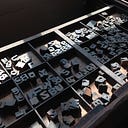HBCUs Are Becoming More White
I googled “myths about Historical Black Colleges and Universities” and found some interesting myths:
· There’s no diversity
· Everyone is Black
· You don’t get to experience what its like being around other people
· They’re racist
After looking at these myths, I did some research on the GSU Library database and found an article by Sarah Butrymowicz called “Historically Black Colleges are Becoming More White.” She writes in this article, “Many HBCUs were started under segregation to provide African-Americans with higher education opportunities. After integration, they became seen as places for black students to overcome economic and educational inequities.” Sarah continues by speaking about Black middle class and how HBCUs have played an important roll in developing this class — turning Black students into teachers, engineers, etc. Here Sarah notes the initial purpose of HBCUs, but she does not stop here — she addresses the paradigm shift that occurred because of desegregation. With desegregation, along came a paradigm shift in Black attendance at HBCUs — many began attending predominantly white schools. Because of this, Sarah says, “To survive, the universities [HBCUs] have had to market themselves to all students.”
If what Sarah says is true, then why doesn’t this diversity reflect in Atlanta HBCUs? Here are the diversity numbers for HBCUs in Atlanta that I got from Collegedata.com:
Morehouse College Ethnicity of Students from U.S.:
0.0% American Indian/Alaskan Native
0.0% Asian
98.3% Black/African-American
0.3% Hispanic/Latino
0.3% Multi-race (not Hispanic/Latino)
0.0% Native Hawaiian/ Pacific Islander
0.1% White
1.0% Unknown
Spelman Ethnicity of Students from U.S.:
0.0% American Indian/Alaskan Native
0.1% Asian
85.6% Black/African-American
0.3% Hispanic/Latino
3.0% Multi-race (not Hispanic/Latino)
0.0% Native Hawaiian/ Pacific Islander
0.0% White
10.9% Unknown
Clark Atlanta University Ethnicity of Students from U.S.:
0.3% American Indian/Alaskan Native
0.2% Asian
88.2% Black/African-American
0.6% Hispanic/Latino
0.0% Multi-race (not Hispanic/Latino)
0.0% Native Hawaiian/ Pacific Islander
0.2% White
10.5% Unknown
I did find two other myths about HBCUs — HBCUs do not prepare you for the real world and that prospective employers may undervalue a degree from an HBCU.
How is HBCU Leadership addressing these myths? Are they addressing these myths? Are these myths?
If what Sarah says is true, than why do the numbers not show HBCUs losing Black students to predominantly white schools, and why isn’t the White student percentage much higher for these schools?
I will address these questions in my next post — tying in the “imaginary” and how the “imaginary” works here.

